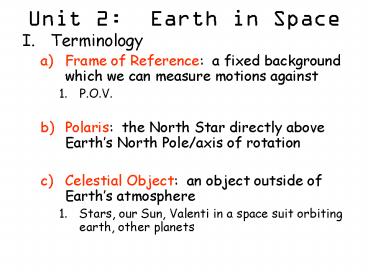Unit 2: Earth in Space - PowerPoint PPT Presentation
1 / 20
Title:
Unit 2: Earth in Space
Description:
Terminology Frame of Reference: a fixed background which we can measure motions against P.O.V. Polaris: the North Star directly above Earth s North Pole/axis of ... – PowerPoint PPT presentation
Number of Views:96
Avg rating:3.0/5.0
Title: Unit 2: Earth in Space
1
Unit 2 Earth in Space
- Terminology
- Frame of Reference a fixed background which we
can measure motions against - P.O.V.
- Polaris the North Star directly above Earths
North Pole/axis of rotation - Celestial Object an object outside of Earths
atmosphere - Stars, our Sun, Valenti in a space suit orbiting
earth, other planets
2
- a) Angular Diameter how large a celestial
object appears to be to an observer - It depends on
- The objects actual size
- How far it is from the observer
- Earths Motions in Space
- Rotation Earth spins on its axis once every 24
hours - Earth turns 15o/hour from west to east-
- -how do we know?
- Day and night- either the sun actually rises
and sets or Earth rotates
3
- Revolution (orbit) Earth moves around the sun
in a nearly circular orbit - Earth orbits the sun in 365.25 days-
- -how do we know?
- Star Shift- constellations appear to change
position each night (slightly) - This is why we see different constellations
during different seasons we see different views
or snapshots at different times
Sun
4
- Seasons and Earth-Sun Relationships
- The Seasons are a result of 3 factors
- Tilted axis of rotation- 23.5o
- Revolution around the sun
- Parallelism- earths axis always point to the
same place in space - It points at the North Star (Polaris)
Polaris
5
- Season Characteristics
- September 21- Autumnal/Fall Equinox
- Direct rays of the sun hit the Equator (0o)
- Because of where we are in space, tilt is neither
towards or away from sun - Everywhere on Earth has 12 hours of
daylight/night - EQUAL on an EQUInox
0o
6
- December 21- Winter Solsitice
- Direct rays of the sun hit the Tropic of
Capricorn (23.5o S latitude) - Because of where we are in space, Northern
Hemisphere is tilted AWAY from the sun - In NYS, we have 8 hours of daylight/16 hours of
night - Shortest day of the year
- Travel north towards the North Pole you approach
locations of 24 hours of night (Artic Circle to
the North Pole)
7
- March 21- Vernal/Spring Equinox
- With the exception of the date and name, its the
same as its twin the Autumnal Equinox!
0o
8
- June 21- Summer Solstice
- Direct rays of the sun hit the Tropic of Cancer
(23.5o N latitude) - Because of where we are in space, Northern
Hemisphere is tilted TOWARD the sun - In NYS, we have 16 hours of daylight/8 hours of
night - Longest day of the year
- Travel north towards the North Pole you approach
locations of 24 hours of daylight (Artic Circle
to the North Pole)
9
- Observing our Moon
- It takes the moon about one month (29.5 days) to
go through a complete cycle of phases - The moons period of rotation and revolution are
the same - We always see the same side of the moon facing
the Earth - Moon Phases- the amount of lit surface as seen
from Earth - Phases are caused by the moons revolution
- The angle and set up of SUN, EARTH and MOON
determines what phase we see
10
- Phases repeat every month in a cyclic manner
- Waxing/1st/New Phases- to see more of the moon
each night - when the light is on the right, the moon is
getting bright - New Moon to Full Moon
- Waning /3rd/Old Phases- to see less of the moon
each night - Waning Fading away
- Getting dark on the right, the moon is getting
erased
11
(No Transcript)
12
(No Transcript)
13
(No Transcript)
14
(No Transcript)
15
- Moons Affect on Earth
- The moons gravity affects our hydrosphere
- Tides are created by the pull of the moon on
the oceans - There are 4 changes in tides in 24 hours
- 2 high tides
- 2 low tides
- This means every 6 hours the level of the oceans
change (from high to low OR from low to high) - Special Tides
- Spring Tides (Severe high and low tides)
- Happens when the moon is Full or New
- Moon and Sun work together to pull on the
oceans making height of tides more extreme
16
The Moons Gravity Causes a change in our tidal
levels throughout the day
17
(No Transcript)
18
- Eclipses
- Lunar Eclipse- Earths shadow is cast on the
surface of a Full Moon - Sun, Earth and moon align exactly in this order
- Happens during a FULL MOON ONLY
- Relatively common (about every 18 months)
- Safe to view
- Visible to everyone on the nighttime side of
Earth - Solar Eclipse- Moons shadow is cast on the
surface of the Earth - Sun, Moon and Earth align exactly in this order
- Happens during a NEW MOON ONLY
- Rare (about 1 every 7 to 10 years)
- Dangerous to view (burns your retinal nerve in
your eyes (youd go blind) - Visible to only certain locations/latitudes on
Earth (you must be located at the right spot on
the daytime side of Earth to experience a solar
eclipse)
19
Lunar Eclipse How do the Sun, Earth and moon
align to create this common celestial phenomenon?
20
Solar Eclipse How do the Sun, Earth and Moon
align to create this more rare phenomenon?































